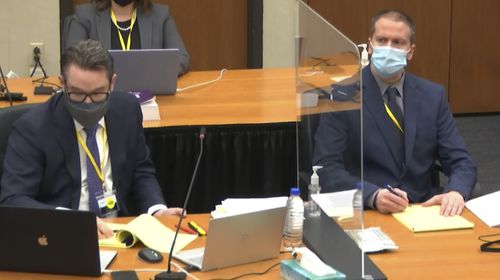The encounter was in 2017 at a Salvation Army shelter where Floyd was a security guard with “this great Southern voice, raspy”, Courteney Ross said on day four of former Officer Derek Chauvin’s murder trial.
The 45-year-old also recounted how both she and her boyfriend struggled with opioid addiction.

“Both Floyd and I, our story, it’s a classic story of how many people get addicted to opioids,” she said.
“We both suffered from chronic pain. Mine was in my neck and his was in his back.”
She said they “tried really hard to break that addiction many times.”
Prosecutors put Ms Ross on the stand as part of an effort to humanise Mr Floyd in front of the jury and portray him as more than a crime statistic.
It was also apparently to explain his drug use to the jurors and perhaps get them to empathise with what he went through.
Mr Chauvin, 45, is charged with murder and manslaughter, accused of killing Floyd by kneeling on the 46-year-old Black man’s neck for 9 minutes, 29 seconds, as he lay face-down in handcuffs last May.
The most serious charge against the now-fired white officer carries up to 40 years in prison.

The defence has argued Mr Chauvin did what he was trained to do and Mr Floyd’s death was caused instead by his illegal drug use, underlying health conditions and the adrenaline flowing through his body.
An autopsy found fentanyl and methamphetamine in his system.
Under cross-examination by defence attorney Eric Nelson, Ms Ross said Mr Floyd’s pet name for her in his phone was “Mama” — testimony that called into question the widely reported account that Mr Floyd was crying out for this mother as he lay pinned to the pavement.
In some of the video, Mr Floyd can be heard calling out, “Mama!” repeatedly and saying, “Mama, I love you! … Tell my kids I love them.”
In her testimony, Ms Ross described how both she and Mr Floyd struggled with their addiction to painkillers throughout their relationship.
She said they both had prescriptions, and when those ran out, they took the prescriptions of others and also used illegal drugs.
“Addiction, in my opinion, is a lifelong struggle,” she said.
“… It’s not something that just kind of comes and goes. It’s something I’ll deal with forever.

In March 2020, Ms Ross drove Mr Floyd to the emergency room because he was in extreme stomach pain, later learning he overdosed.
In the months that followed, she said, spent a lot of time together during the coronavirus quarantine, and Mr Floyd was clean.
She suspected he began using again about two weeks before his death because his behaviour changed.
She said there would be times when he would be up and bouncing around and other times when he would be unintelligible.
Ms Ross began her testimony by telling how the two of them met.
“May I tell the story?” she asked.
“It’s one of my favorite stories to tell.”
The witness said she had gone to the shelter because her sons’ father was staying there.
She said she became upset because the father was not coming to the lobby to discuss their son’s birthday. Mr Floyd came over to check on her.
“Mr Floyd has this great Southern voice, raspy. He was like, `Sis, you OK, sis?'” Ms Ross recalled.
“I was tired. We’ve been through so much, my sons and I, and (for) this kind person just to come up and say, ‘Can I pray with you?’ … it was so sweet.
“At the time, I had lost a lot of faith in God.”

Minnesota is a rarity in explicitly permitting such “spark of life” testimony about a crime victim ahead of a verdict.
Defence attorneys often complain such testimony allows prosecutors to play on jurors’ emotions.
The footage also showed Mr Floyd being loaded into an ambulance.
When Mr Floyd was finally taken away, a bystander objected to what Mr Chauvin had done.
“That’s one person’s opinion,” Mr Chauvin could be heard responding.
“We gotta control this guy ’cause he’s a sizable guy … and it looks like he’s probably on something.”
Mr Floyd was 193 centimetres and 101 kilograms, according to the autopsy.
Mr Chauvin’s lawyer said the officer was 175 centimetres and 64 kilograms.
This content first appear on 9news
